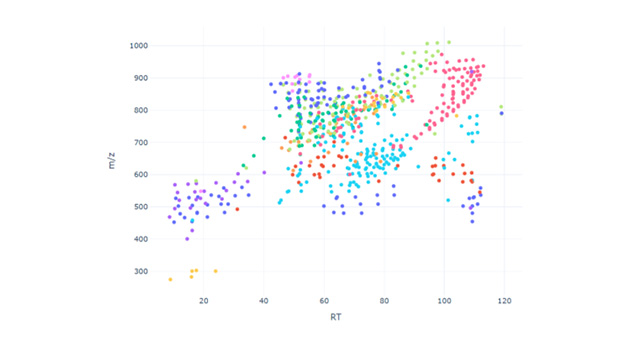In settings where researchers have very focused scientific questions or have developed such questions through untargeted experiments with GMet, we will team up to design targeted lipidomic studies based on up to 20 lipid standards provided by the customer. These studies will deliver high-confidence, translatable results that can provide quantitative metabolite read-outs, if needed.
GMet’s targeted lipidomics analysis method has been designed to efficiently handle a wide range of studies from small lab scale to very large population scale efforts. With our high throughput targeted lipidomics methods, we can acquire and process data and return analysis of sample cohorts from up to 1500 samples in typically 2-3 weeks.

Mass vs. time array of non-targeted lipidomics data. Each colored dot represents a lipid or fatty acid detection event, with RT in seconds.
GMet’s untargeted lipidomics analysis method has been designed to efficiently handle small lab based studies as well as those with large sample numbers. With our high throughput untargeted lipidomics methods, we can acquire and process data and return analysis of cohorts from up to 1500 samples in typically 2 weeks. GMet’s untargeted lipidomic method provides very rapid chromatographic resolution and MS2 fragmentation data for all major lipid classes in human plasma, as well as the capability to target additional, specific lipid species based on the experimental design. Lipids are identified through retention time as well as spectral matching of collision induced fragmentation data with established MS2 fragmentation libraries, providing clear assignment of lipid classes and acyl side chain length and oxidation level. Typical lipid class coverage includes: Acyl-carnitines (AC), Free cholesterol (FC), Cholesterol esters (CE), Ceramides (Cer), Glucosyl ceramides (GlcCer), Lysophosphoethanolamines, cholines, and serines (LysoPE/PC/PS), Mono, di, and acyl glycerols (MG/DG/TG), Phosphatidic acids (PA), Phosphatidyl cholines (PC), Phosphatidyl glycerols (PG), Phosphatidyl ethanolamines, (PE), Phosphatidyl inositols (PI), Phosphatidyl serines (PS).
GMet is a unique metabolomics service provider founded by leaders in the field of metabolomics with a strong track-record of harnessing its utility in life sciences. Contact us today to discuss your project with us.